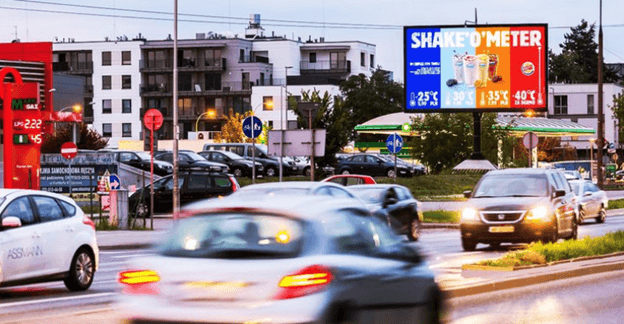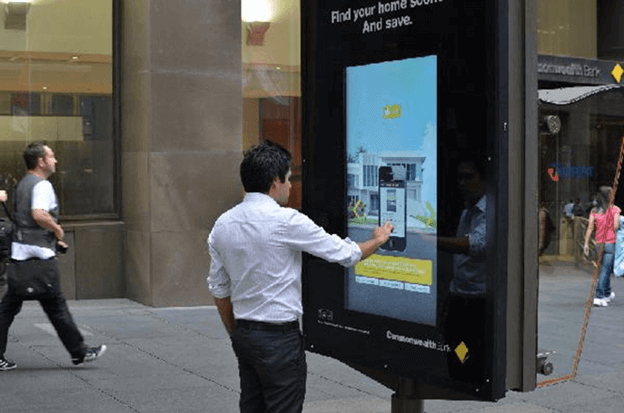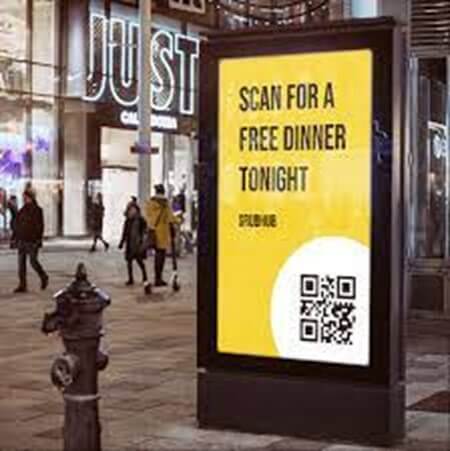
Introduction
OOH (out-of-home) advertisements have seen many phases of growth. In every medium, including transit ads, billboards, etc., in the advertising industry, it is crucial to stay relevant with the content and with the generation of the audience. OOH ads have also utilized these technologies and incorporated them into their advertisements.
In this article, we will mainly focus on transit advertisements and understand the innovations and improvements in technologies that they have gone through. We will also be looking at how these changes have impacted the OOH industry.
Transit advertising

Transit advertising is a form of OOH (Out-of-home) advertising. This media form is used by various businesses worldwide. Transit ads are placed mainly in modes of public transport where there is maximum public interaction. Advertisers use them to promote new movies, launch campaigns, and promote brand awareness messages.
Transit ads are very versatile in their presence. This form of advertising is designed to reach a broad audience as people commute or travel within a specific geographic area. They can include both traditional and digital formats. Let’s look at some of the types of transit ads.
- Subway and Train Ads
These ads are placed along the subway platforms and inside the trains. There are millions of people taking the subway services every day, and these ads target this mass audience to promote their products and messages.
- Bus Advertising
These ads are specific to buses and other street vehicles like trucks. Bus ads target customers in a similar way to train ads. Their advantage is that these vehicles travel around the city always with the potential of catching a new customer. Bus ads are wrapped around the vehicles or presented inside the buses. Either way, these ads promote campaigns, product launches, and new releases.
- Taxi and Rideshare Advertising
As the name suggests, these ads are placed on taxis for maximum visibility on the road. Taxi ads are personalized and target a specific audience. They can be from a small start-up or an established brand.
- Airport Ads
Ads placed in airport terminals waiting areas and high-traffic areas. These ads are targeted and mainly placed by popular brands. They also place electronic displays showcasing advertisements to travelers. Baggage claim and shuttle advertising ads in areas where passengers pick up luggage or use transportation services.
- Bicycle and Pedestrian Advertising
These ads are seen placed on bicycles or stations in bike-sharing programs. Pedestrian zones in high-traffic pedestrian areas or on street furniture.
- Air Ads
It is also known as airplane banner advertising, air ads, or skywriting. Aerial advertising can be an effective way to reach a large audience, as it can be seen from a great distance. It is also relatively low cost when compared to other forms of advertising, such as television or radio.
Traditional transit ads

Traditional transit ads are the tried-and-true champs of advertising, showing up on buses, trains, and stations in the form of eye-catching posters and wraps. These tangible, visual gems make a lasting impression on daily commuters, offering a straightforward yet powerful way to share messages and build brand awareness. In a world buzzing with digital noise, traditional transit ads stick around, delivering a simple and effective means to connect with people during their daily travels. Their strength lies in clear visuals and concise messages, making them a budget-friendly and impactful choice for local and city-wide advertising. Sometimes, the classics are classics for a reason!
The history of out-of-home advertising dates to the 19th century, marked by the introduction of static billboards that remained largely unchanged for decades, offering limited engagement with the audience. However, the advent of the digital age sparked a revolutionary transformation. As the wheels of progress turn, traditional transit ads are now leaping into the digital era, ushering in a new wave of innovation and engagement. This evolution, from tangible prints to dynamic digital displays, has reshaped the way advertisers connect with commuters on the move, opening avenues for interactive and personalized campaigns that transcend the limitations of static billboards.
Digital out-of-home (DOOH) Ads
Enter the digital age.

As we entered the digital age, a significant shift occurred in transit advertising. The old static prints that we were accustomed to on buses, trains, and stations evolved into dynamic digital displays. This change wasn’t just about a visual upgrade; it introduced a whole new level of connectivity. Now, advertisers can speak to their audience in real-time, making the advertising experience more interactive and engaging. The days of passive viewing were over; it was time for commuters to actively participate in the messages around them, marking a transformative phase for transit advertising.
Real-time targeting
The concept of real-time advertising is a game changer, this gives advertisers the power to deliver messages dynamically and in real-time. Content does not have to be one size fits all anymore, there is enough liberty to have a personalized content approach.
Real-time targeting allows advertisers to tailor their content on the fly, considering specific factors such as the current location, demographics of the audience, and even the time of day. For instance, a morning commute might feature ads tailored to wakefulness, while the evening journey could showcase content more aligned with relaxation.
Burger King’s “Shake’O’Meter” campaign

Burger King introduced their campaign where they used real-time advertising; they altered the price of their shakes according to the weather in the moment—the higher the temperature, the lower the price. The campaign reached 8 million people, according to figures cited in Digital Signage Today, and product awareness increased significantly, with shake sales increasing by 13%.
Interactivity takes the spotlight.

The digital revolution introduced interactivity into its advertisements, this allowed consumers to actively participate in the content instead of just observing and reading it. This shift introduces interactive touchpoints, like touchscreens and augmented reality (AR), turning the once one-sided encounter into a two-way street.b
Transit ads especially provide a lot of information, for example, consider traveling a new route in the subway, there are multiple screens laid that people could use to get information with just a few clicks, this not only creates interaction but also helps make meaningful connections with the brand. The digital revolution has truly put commuters at the center stage of the advertising experience.
Integrated bus shelters in Szczecinek with dynamic passenger information displays in LED and LCD TFT technology.
Dysten equipped 24 modern integrated bus shelters for the city of Szczecinek, Poland. Each bus shelter features a passenger information board with LED technology, dynamically displaying the departure times of buses. 360-degree cameras ensure monitoring and guarantee passenger safety. Additionally, 47-inch LCD monitors (one for each bus shelter) display city information. Thanks to the built-in brightness sensor, the displays automatically adjust their brightness based on the ambient light intensity.
Geotargeting and retargeting
Geotargeting techniques allow advertisers to work with precision. They can target ads based on user location, ensuring that the content is contextually relevant and making the most out of their resources and space. This precision in targeting enhances the impact of transit ads by delivering content that aligns with the local culture and preferences of the audience.
Retargeting is an extended concept, it is said that around 97% of consumers exposed to digital ads, mobile ads, OOH ads, or whatever media a brand uses for its advertising campaign, will not make a purchase immediately after first encountering a particular product or service. To convince them to make that purchasing commitment, brands must engage in some kind of strategic follow-up activity. It could be online or OOH, the customers are contacted or the advertisement follows them to help them make the purchase and interact with the brand. This way digital and OOH work hand in hand to make the most revenue and have loyal customers.
Data-driven insights

Data is a treasure for advertisers. Knowing the number of people who watched their ad, the location with the most interaction, the demographic of the audience, etc., helps a lot in narrowing down strategies and locations for content creators. It also helps the brand understand the genre of its audience, enabling necessary alterations in the advertisement. How is the data collected, you ask?
- Mobile Tracking and Geofencing: OOH advertisers leverage mobile tracking technologies and geofencing to collect data from mobile devices within a specific geographic area. This data can provide information on the number of people passing by, the duration of their stay, and their potential interests.
- Wi-Fi and Bluetooth Technology: Some transit ads use Wi-Fi and Bluetooth technology to detect and connect with nearby devices. This helps in gathering the data of the devices in proximity to find out the foot traffic and potential audience.
- Surveys and QR Codes: Incorporating surveys and QR codes will only encourage commuters to participate. This will help get valuable feedback from consumers. Ads can also throw in some free coupons, promo codes, and games to encourage people to participate more often.
- Camera Technology: Advanced camera technology can be employed to capture and analyze crowd movement. The algorithm can access the number of people, demographics, and other useful information.
- Social Media Monitoring: Monitoring social media platforms for mentions, tags, or check-ins related to specific OOH ads provides firsthand consumer data.
- Third-Party Data Providers: OOH advertisers may collaborate with third-party data providers who offer anonymized and aggregated data on consumer behavior.
- Smart Infrastructure Integration: Some modern transit locations have smart infrastructure, including sensors and beacons. This helps understand the pattern and behavior of commuters.
Dynamic Canvases
Digital displays have opened the doors for creativity; the canvas is no longer plain and white. The innovation in digital out-of-home ads now allows brands to create immersive experiences with their advertisements. Brands can tell compelling stories, change visuals dynamically, and make content more interactive. This flexibility was missing with static billboards. Campaigns can now be 3D, characters look realistic, and the audience enjoys the presentation, always waiting for more. All of this happens in real time. Moreover, the advertiser has the remote to the content displayed; they can decide when and what to present, making it the best part of DOOH. This evolution is the best that OOH has seen so far, and it’s only getting better.”

Conclusion
As much as traditional billboards are still appreciated and well-received, we can say that digital evolution has made them step up their game. The innovations not only make things easier but also provide flexibility for advertisers to be creative. From being static billboards to absolutely sweeping us off our feet, transit ads are here to take us on a trip. Literally!


